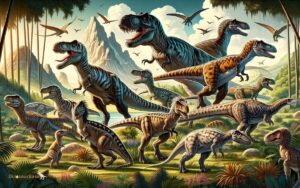Can You Carbon Date Dinosaur Bones
In the vast expanse of time that separates modern humans from the titanic dinosaurs, one might imagine that carbon dating could easily bridge this gap. However, scientists face a formidable challenge when attempting to apply carbon-14 dating to dinosaur bones.
This method, while revolutionary in understanding the age of organic materials, loses its efficacy beyond 50,000 years, leaving the true age of dinosaurs shrouded in mystery.
Yet, the quest to pinpoint the age of these ancient behemoths has not reached a standstill. Exploring alternative dating methods opens a fascinating chapter in unraveling Earth's prehistoric past, inviting further inquiry into the depths of time itself.
Key Takeaways
- Carbon dating is ineffective for dinosaur bones due to their age and carbon-14's half-life limitations.
- Dinosaur fossils often lack preserved organic material necessary for carbon dating.
- Alternative dating methods, like Potassium-Argon and Uranium-Lead, are used for accurately dating dinosaur remains.
- The state of fossil preservation and geological context significantly influence the choice of dating techniques for dinosaur bones.
Understanding Carbon Dating
Carbon dating is a cornerstone technique in archaeology and paleontology. It measures the decay of carbon-14 isotopes to estimate the age of organic materials. This radiometric dating method leverages the predictable decay rate of carbon-14, a radioactive isotope of carbon. Living organisms constantly absorb carbon-14 through the atmosphere; however, upon death, this absorption ceases, and the carbon-14 begins to decay.
The Age of Dinosaurs
Dinosaurs, the colossal inhabitants of Earth's ancient past, roamed our planet during the Mesozoic Era, which spanned from about 252 to 66 million years ago. This era is further divided into three periods: the Triassic, Jurassic, and Cretaceous. Each period witnessed the evolution and extinction of diverse dinosaur species, reflecting significant geological and climatic changes over time.
The Mesozoic Era's end, marked by the Cretaceous-Paleogene extinction event approximately 66 million years ago, led to the demise of nearly all dinosaur species, making way for the rise of mammals. Understanding the precise ages of dinosaurs is crucial for paleontologists, as it helps unravel the complex history of Earth's biodiversity and climatic shifts. Thus, accurately dating dinosaur fossils is of paramount importance in the study of their existence and evolution.
Limitations of Carbon Dating
The accuracy of carbon dating faces significant challenges when applied to dinosaur bones, primarily due to the half-life of carbon-14. Preservation of organic material in fossils is rare, making the technique less reliable for specimens millions of years old.
Additionally, contamination from modern carbon sources can further skew results, complicating the dating process.
Carbon-14 Half-Life Limitations
Understanding the limitations of carbon-14 dating is crucial, particularly its half-life of 5,730 years, which restricts the method's effectiveness to materials no older than about 50,000 years. The decay of carbon-14 to nitrogen-14 over time means that after several half-lives, insufficient carbon-14 remains to provide an accurate date. This limitation impacts the study of ancient materials for several reasons:
- Temporal Range: Beyond approximately 50,000 years, the carbon-14 content drops to near indetectable levels, making accurate dating impossible.
- Precision: As the half-life progresses, the error margin in dating increases, reducing the method's precision.
- Applicability: The method can't be applied to materials outside the carbon cycle or those predating the upper limit of carbon-14's effective range.
Material Preservation Impact
Analyzing the impact of material preservation on carbon dating reveals how degradation processes can significantly limit the technique's accuracy and applicability. Over time, organic materials intended for radiocarbon dating undergo various forms of decay and alteration, including microbial action and chemical changes. These processes can deplete the original carbon-14 content, introducing considerable challenges in obtaining accurate age estimations.
Furthermore, the physical state of specimens plays a crucial role. Well-preserved samples, shielded from environmental factors, offer more reliable data. However, such conditions are rare for materials spanning back millions of years, like dinosaur bones. Consequently, scientists must often grapple with the limitations imposed by the state of preservation, affecting the precision and utility of carbon dating in studying ancient life.
Contamination Risks Explored
Beyond the challenges posed by material preservation, contamination risks significantly undermine the reliability of carbon dating when analyzing ancient specimens like dinosaur bones. The precision of carbon dating, a method reliant on the decay rate of Carbon-14 to estimate the age of organic materials, is highly susceptible to external contamination. This vulnerability introduces significant uncertainties in the dating of specimens as ancient as dinosaur fossils.
Key contamination risks include:
- Fossil handling and preparation: Modern carbon can infiltrate specimens during collection or preparation, skewing results.
- Environmental exposure: Minerals and other carbon sources can replace original material over millennia, complicating age determination.
- Chemical treatments: Conservation efforts often involve chemicals that contain contemporary carbon, further contaminating samples.
These factors necessitate meticulous protocols to mitigate contamination, yet they can't always be fully eliminated, underscoring the limitations of carbon dating for ancient remains.
Why Dinosaurs Elude Carbon-14
Despite its widespread application in archaeological dating, carbon-14 dating can't be used to date dinosaur bones due to their age far exceeding the method's effective range. The half-life of carbon-14, approximately 5,730 years, limits its utility to materials up to about 50,000 years old. Dinosaurs, having last roamed the Earth over 65 million years ago, fall well beyond this temporal threshold.
Consequently, any carbon-14 found in dinosaur remains would have decayed long ago, leaving no trace for scientists to analyze. This absence renders the method ineffectual for studying such ancient specimens. Moreover, the principle underlying carbon-14 dating relies on the presence of this isotope in living organisms. Since dinosaurs have been extinct for millions of years, they no longer contain measurable amounts of carbon-14, further compounding the challenge of dating them using this technique.
Alternative Dating Methods
To overcome the limitations of carbon-14 dating for ancient specimens, scientists employ a range of alternative dating methods tailored to the vast timescales of dinosaur fossils. These techniques provide more accurate estimates for the age of dinosaur remains, which are far beyond the reach of carbon-14's effective dating range.
- Stratigraphy: This method analyzes the layers of rock in which fossils are found to determine their relative age. Fossils within the same stratum are typically of similar age.
- Paleomagnetic dating: This technique examines the Earth's magnetic field reversals captured in rocks to date fossils.
- Biostratigraphy: Leveraging the known ages of other fossilized organisms, scientists can approximate the age of dinosaur fossils found in the same or comparable layers.
These methods collectively enable a more nuanced understanding of dinosaur chronology, sidestepping the limitations of carbon dating for such ancient relics.
Radiometric Dating Explained
Building on the foundation of alternative dating methods, radiometric dating stands out as a pivotal technique for accurately determining the ages of dinosaur fossils by measuring the decay of radioactive isotopes within them. This method relies on the principle that certain isotopes of elements, inherently unstable, transform into stable forms at a constant rate over time.
Scientists can calculate the age of a fossil by comparing the ratio of the original radioactive isotope to its decay products. This calculation, inherently precise, hinges on the half-life of the isotopes, which is the time it takes for half of the radioactive element to convert to a stable form. Radiometric dating, therefore, offers a quantifiable means of pinpointing the era a dinosaur roamed the Earth, bypassing the limitations of other dating methods that may not directly apply to such ancient materials.
Utilizing Potassium-Argon Dating
Potassium-Argon dating significantly enhances our ability to date volcanic layers above and below dinosaur fossils, offering a precise timeline of their existence. This method relies on measuring the ratio of radioactive potassium-40 to argon-40 in volcanic rock. Since potassium-40 decays into argon-40 over time, scientists can determine the rock's age, providing a frame of reference for the fossils it encases.
- Accuracy: Potassium-Argon dating offers a high degree of accuracy for dating events up to billions of years ago, crucial for studying dinosaurs.
- Range: It fills a critical gap, dating materials that are beyond the reach of carbon dating.
- Applicability: This technique is particularly useful in dating volcanic layers, enabling a direct association with dinosaur fossils found in or between these layers.
The Role of Uranium-Lead Techniques
In the realm of dating ancient materials, the Uranium-Lead technique emerges as a pivotal method, offering unparalleled precision and reliability for determining the age of the oldest rocks on Earth. This technique exploits the decay of uranium isotopes into lead over immense periods, providing a clock that measures time spans up to billions of years with astonishing accuracy.
Researchers meticulously analyze the ratio of uranium to lead in mineral samples, allowing them to pinpoint the formation age of rocks with a precision that other methods struggle to match. This accuracy is crucial for dating the Earth's crust, meteorites, and, by extension, offers a backdrop for understanding the age of dinosaur fossils indirectly.
The Uranium-Lead method stands as a cornerstone in the geochronology field, bridging gaps in our temporal understanding of Earth's history.
Dinosaur Fossils and Stratigraphy
Dinosaur fossils, encapsulated within the Earth's sedimentary layers, offer a critical lens through which stratigraphic dating methods are refined and understood.
The identification of fossil layers serves as a cornerstone in establishing the temporal sequence of geological and paleontological events.
Consequently, stratigraphic dating methods not only corroborate the chronological order of these events but also enhance our understanding of Earth's historical landscape.
Fossil Layers Identification
Understanding the stratigraphic distribution of dinosaur fossils is crucial for accurately dating and categorizing these ancient remains within specific geological periods. This process involves identifying and analyzing the sedimentary layers in which these fossils are found. Such identification is pivotal for constructing a timeline of dinosaur evolution and extinction.
To enhance understanding, consider the following key aspects:
- Sedimentary Rock Layers: Dinosaurs are primarily found in sedimentary rocks, which are formed from accumulated sediments. These layers provide a sequential record of Earth's history.
- Index Fossils: Certain fossils, known as index fossils, are characteristic of specific geological periods and assist in correlating the age of the layers.
- Taphonomic Processes: The study of how organisms decay and become fossilized within these layers offers insights into the environmental conditions of the time.
This methodical approach facilitates a comprehensive understanding of the age and context of dinosaur fossils, underscoring the importance of stratigraphy in paleontology.
Stratigraphic Dating Methods
Stratigraphic dating methods provide a framework for interpreting the chronological sequence of dinosaur fossils within sedimentary layers, offering precise insights into their temporal distribution. These methods leverage the principle of superposition, which posits that in an undisturbed sequence of sedimentary rocks, older layers lie beneath younger ones.
Scholars meticulously analyze the stratigraphic context, correlating layers across different locations to piece together the historical narrative of Earth's past life. This approach allows them to construct a relative timeline, situating dinosaur species within specific geological periods. Moreover, stratigraphy aids in identifying contemporaneous flora and fauna, enriching the understanding of ancient ecosystems.
Thus, stratigraphic dating serves as a cornerstone in paleontology, underpinning the study of dinosaur evolution and their interaction with the changing environment.
Insights From Paleomagnetic Data
Amidst the ongoing analysis of dinosaur bones, insights from paleomagnetic data have emerged as a crucial tool in unraveling the Earth's geomagnetic history during the Mesozoic era. This method offers a unique perspective by analyzing the magnetic minerals in rocks formed contemporaneously with dinosaurs. These minerals record the Earth's magnetic field at the time of their formation, providing valuable data on past continental movements and climate changes.
Key contributions from paleomagnetic studies include:
- Chronology Establishment: They help in precisely dating geological strata, complementing other dating methods.
- Tectonic Reconstructions: They offer insights into the movement of tectonic plates, crucial for understanding dinosaur migration and distribution patterns.
- Climate Insights: They assist in reconstructing past climates, shedding light on the environments in which dinosaurs thrived.
Dendrochronology in Historical Context
How does the study of tree ring patterns, or dendrochronology, provide a window into the historical context of our planet's climatic and ecological changes?
Dendrochronology, by examining the annual growth rings of trees, offers unparalleled insights into past climates, environmental conditions, and even historical events. Each ring signifies a year of growth, with variations in width and density reflecting annual climatic variations. Researchers meticulously analyze these patterns to reconstruct past climates and understand how ecosystems responded to changes over time.
This method, grounded in precise and detailed examination, bridges the gap between the present and ancient worlds, providing a chronological framework that enhances our understanding of Earth's complex environmental history. It's a cornerstone of paleoclimatology, enabling scientists to decipher the planet's ecological past with remarkable accuracy.
Applying Luminescence Dating
Luminescence dating, a crucial tool in the geochronologist's arsenal, provides accurate estimates of the time elapsed since mineral grains were last exposed to sunlight or heat. This method is particularly useful for dating materials that carbon dating cannot, including sediments surrounding dinosaur bones.
The analysis involves:
- Measuring trapped electrons: Minerals accumulate electrons over time when not exposed to sunlight.
- Estimating the last exposure: The technique quantifies the amount of luminescence released, reflecting the time since the mineral was last heated or exposed to sunlight.
- Cross-verifying dates: It often complements other dating methods to increase reliability.
Advances in Molecular Clock Dating
Recent advancements in molecular clock dating have significantly enhanced the precision of estimating the age of dinosaur bones. This methodology's accuracy now allows scientists to compare its results directly with those obtained from traditional radiometric dating techniques, offering a broader understanding of paleontological timelines.
Such comparisons are pivotal in refining our historical narratives of dinosaur evolution and their eventual extinction.
Molecular Clock Accuracy
Advances in molecular clock dating have significantly enhanced our understanding of evolutionary timelines by improving the accuracy of genetic mutation rate estimates. This methodology relies on the premise that mutations accumulate at a consistent rate over time, functioning as a clock to gauge the age of genetic divergences. However, the precision of molecular clock dating hinges on several factors:
- Calibration Techniques: The accuracy of molecular clocks is significantly influenced by the calibration methods used, which involve comparing genetic data with fossil records.
- Mutation Rate Variability: Mutation rates can vary among different species and even within the genomes of a single organism, affecting the reliability of molecular clocks.
- Environmental Factors: External conditions such as temperature and radiation can influence mutation rates, introducing variability into molecular clock estimates.
These elements underscore the complexity of accurately dating evolutionary events and highlight the ongoing efforts to refine molecular clock methodologies.
Dating Techniques Comparison
In comparing dating techniques, it's evident that the refinement of molecular clock dating has markedly narrowed the gap between genetic and fossil evidence, offering a more cohesive view of evolutionary timelines. This advancement is pivotal in understanding the chronology of life on Earth.
Traditionally, paleontologists relied on the stratigraphic context of fossils to estimate their age. However, the integration of molecular clock dating has provided a nuanced method that complements and sometimes corrects fossil-based estimations. By analyzing the mutation rates of biomolecules, scientists can infer the timing of evolutionary divergences with greater precision.
This technique not only corroborates fossil evidence but also fills in the temporal gaps that fossils alone can't address, thereby enriching our comprehension of evolutionary history with a more accurate and detailed timeline.
Conclusion
In conclusion, while carbon dating's lantern illuminates the path of history up to a certain epoch, it flickers out in the face of the ancient behemoths that roamed the Earth millions of years ago. Dinosaurs elude the grasp of Carbon-14 due to its temporal limitations.
However, the arsenal of alternative dating methods, from luminescence to molecular clocks, offers a broader spectrum to decipher the age of these colossal creatures, enriching our understanding with precise and varied historical insights.






